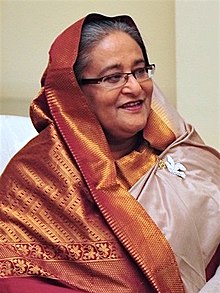Prime Minister of Bangladesh
| Prime Minister of the People's Republic of Bangladesh গণপ্রজাতন্ত্রী বাংলাদেশের প্রধানমন্ত্রী |
|
|---|---|

Prime ministerial emblem
|
|

Prime ministerial standard
|
|
| Style | The Honourable |
| Member of | |
| Residence | Gonobhaban, Dhaka |
| Seat | Prime Minister's Office, Tejgaon, Dhaka |
| Appointer | President of Bangladesh |
| Term length | The prime minister is by convention the leader of the victorious party. No term limits are imposed on the office. |
| Inaugural holder | Tajuddin Ahmed |
| Formation | 26 March 1971 |
| Website | pmo |
The Prime Minister of the People's Republic of Bangladesh (Bengali: বাংলাদেশের প্রধানমন্ত্রী – Bangladesher Prôdhan'môntri) is the Head of the Government of Bangladesh. The Prime Minister and the Cabinet are collectively accountable for their policies and actions to the Parliament, to their political party and ultimately to the electorate. The current Prime Minister, Sheikh Hasina Wajed, were appointed on 6 January 2009 by the President of Bangladesh.
According to the Constitution the Prime Minister is appointed by the President based upon the result of the electorates choice in parliamentary general election held by the Election Commission. The Prime Minister will be the leader of the majority party (or coalition) in the Jatiya Sangsad and must have the confidence of the Jatiya Sangsad to govern. The cabinet is composed of ministers selected by the prime minister and appointed by the president. At least 90% of the ministers must be MPs. The other 10% may be non-MP experts or "technocrats" who are not otherwise disqualified from being elected MPs. According to the constitution, the president can dissolve Parliament upon the written request of the prime minister.
The office of the Prime Minister is located at Tejgaon in Dhaka city. It is considered a ministry of the government and among other duties, provides clerical, security, and other support to the prime minister, governs intelligence affairs, NGOs, and arranges protocol and ceremonies.
In September 1991, the electorate approved changes to the constitution, formally creating a parliamentary system and returning governing power to the office of the prime minister, as in Bangladesh's original constitution. In October 1991, members of parliament elected a new head of state, President Abdur Rahman Biswas.
Khaleda Zia served as Prime Minister of Bangladesh three times, since 1991. Once in power, Khaleda Zia's government made substantial changes in education policy, introducing free education for girls up to the 10th grade, a stipend for female students, and food for education programme funds. It also made highest budgetary allocation in the education sector.
...
Wikipedia

